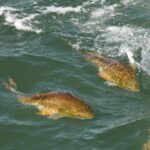
Gulf Menhaden Reduction Fishery: Bycatch Research & Useless Buffer Zones
Do you remember your driver’s test? How nervous were you when the instructor pulled out
Tony Friedrich VP/Policy Director
You may have missed this. We understand. We are a little late writing about it for the same reasons. We all need some good news these days. This is actually some great news.
Before you read this, put your partisan sabers down. This is about conservation. As we always say, “conservation knows no party.” It is one of the few things that brings us together. Americans love the outdoors and rightly so.
On June 17th, the Senate passed the Great American Outdoors Act (S. 3422), which would permanently fund the Land and Water Conservation Fund (LWCF) as well as address the maintenance backlog on public lands. If signed into law, this legislation will be the largest public lands funding since the days of Teddy Roosevelt.
Why would the American Saltwater Guides Association care about public lands funding? Have you ever fished Cape Cod National Seashore in Massachusetts, Sandy Hook in New Jersey, or the Outer Banks in North Carolina? All have been protected and funded via the LWCF. Furthermore, we desperately want all Americans, especially kids, to embrace our outdoor legacy. The LWCF provides the funding needed to keep these places open and safe for recreation. Here’s the best part, the funding doesn’t come from taxpayers. It comes from royalties related to offshore energy production.
This legislation will go a long way keeping our love of the outdoors alive and well. This means a lot to our country. Apparently, it means a lot to the U.S. Senate because there were only 25 nay votes and 59 co-sponsors for the legislation. This is a clear indicator of the value of the bill.
S. 3422 does a lot of incredible things for fishermen, hunters, and other outdoor enthusiasts. This is going to get a little in-depth and we apologize. If you love the outdoors as much as we do, it is worth your time. Let’s get started.
Here’s some language from the original title:
A bill to amend title 54, United States Code, to establish, fund, and provide for the use of amounts in a National Parks and Public Land Legacy Restoration Fund to address the maintenance backlog of the National Park Service, the United States Fish and Wildlife Service, the Bureau of Land Management, the Forest Service, and the Bureau of Indian Education, and to provide permanent, dedicated funding for the Land and Water Conservation Fund, and for other purposes.
The LCWF was signed into law in the mid-1960s by President Lyndon Johnson. It is a “Federal program supports the protection of federal public lands and waters – including national parks, forests, wildlife refuges, and recreation areas – and voluntary conservation on private land. LWCF investments secure public access, improve recreational opportunities, and preserve ecosystem benefits for local communities.”
The list of accomplishments from the LWCF is impressive. Here are a few:
Provides matching grants to state and tribal governments for the acquisition and development of public parks and other outdoor recreation sites. Grants have funded projects in every county in the country, over 40,000 projects since 1965. Number of projects = 41,999. Funding provided = $3.9 billion.
Grants provide funds to states and territories to work with private landowners, conservation organizations, and other partners to protect and conserve the habitat of threatened and endangered species. Number of grants = 246. Funding provided = $394 million.
Provides grants through state partners to protect environmentally sensitive forest lands while maintaining private ownership and working forests. Total acres protected = 2.37 million. Funding provided =$1.4 billion.
The LWCF goes far beyond protecting forests, inland waters, and everything that needs them to survive. This fund has helped projects in almost every county in the United States. It directly pays for playgrounds, ball fields, and even swimming pools. The intention of the fund was to provide outdoor recreation for all. It doesn’t matter if you live in the mountains or an inner city, the LWCF was designed to impact each and every one of us. The writers of the bill knew that our citizens would be benefit greatly by having places outside to recreate.
What are the bottom-line impacts of the LWCF? The estimates are staggering. For every dollar funded, there is a four-dollar impact. That is incredible!
The Department of Commerce keeps close tabs on the economic impact of the outdoor recreation industry. In 2017, it was 2.2% of the GDP, or $427.2 billion. The outdoor recreation economy actually grew by 3.9% in 2017, faster than the 2.4% of the overall economy. Recreational fishing and boating was the largest conventional activity with almost $21 billion in impact.
The real impacts are hard to quantify. How many kids developed a love for the outdoors in these places? How many kids learned to play a sport? How many parlayed that into a chance to go to college? The LWCF is what America is all about. It has probably positively impacted you and you may not have known.
This fund was established over 50 years ago. The royalties should fund $900 million per year for projects. It has only been fully funded twice since it began.
Unfortunately, some of the dollars have been appropriated for other things. The LWCF lost over $20 billion over the years from being raided. We are not going to dwell on this. What is done is done. It can be fixed.
The Great American Outdoors Act will not only guarantee the $900 million per year, it will also secure and protect those funds from future diversion.
We are still in a bad situation from our past mistakes. There is an $11.6-billion backlog of deferred maintenance in the National Park Service alone. When you add the U.S. Forest Service, the U.S. Fish and Wildlife Service, the Bureau of Land Management, and the Bureau of Indian Education, we are over $20 billion in the hole for needed maintenance.
The Great American Outdoors Act includes establishing a new National Parks and Public Lands Legacy Restoration Fund in Section 2. This fund’s sole purpose is to address the backlog. This new fund would receive $1.9 billion annually for the next five years and max out with a $9.5 billion total. The money would not come out of LWCF. However, it would come from onshore and offshore energy revenues just like the LWCF.
This will go a long way in providing access to the outdoors for all Americans. Remember that this is not just about fishermen. This is also about underserved populations that have every right as American citizens to enjoy the outdoors. The Great American Outdoors Act will also ignite the economy. We all know how rough it has been lately. This legislation will create jobs across the entire industry as well as within the maintenance backlog. We can’t afford to let this effort fall short.
The Great American Outdoors Act has only gotten through the Senate. The next step is passing the House of Representatives. The President has stated repeatedly that he will sign this bill into law.
We need to let our representatives know that this means something for each and every citizen of this country. We need to ask for their support in getting this one over the line. Chances like this do not happen often. Please, join us in our call to support the Great American Outdoors Act.
If you are the member of a fishing, hunting, boating, biking, birdwatching, running, hiking, or any outdoors club, get them to support this by sending an email on their letterhead. If you would love a new ballfield in your area, call your representative. If you want the younger generation to be a part of the greatest legacy in our country’s history, do your part.

Do you remember your driver’s test? How nervous were you when the instructor pulled out

If you’ve spent any time on the water in South Florida, chances are you’ve heard

Photo Credit: Graham Tayloe Big Win for Redfish in Alabama Huge news from the Marine

Feature Photo: Carter Abramson | Simms Fishing at the Fisheries Science Symposium We have more
We rely on our members and donations to keep fighting for a sustainable tomorrow in marine conservation.
GIVE THE GIFT OF FISHERIES CONSERVATION THIS HOLIDAY SEASON. SHOP ASGA GOODS THAT FUND FISHERIES RESEARCH & ADVOCACY CAMPAIGNS
JOIN ASGA IN CALLING FOR CRITICAL MANAGEMENT ACTION AFTER YEARS OF SPAWN FAILURES & POOR MANAGEMENT.
By using this website, you agree to our use of cookies. We use cookies to provide you with a great experience and to help our website run effectively. To learn more, please review our privacy policy.
2 Responses
I am very green (inexperienced) in matters of Federal land use policy, but I get suspicious when I read that this is funded by offshore oil royalties. Is this a play to make it easier to permit offshore oil drilling? e.g. If you don’t pass the drilling bill there won’t be any money for the LWCF.
Parker,
That is a good question!
This has been in effect since 1965. So, not much of a current play. Oil companies are extracting a natural resource through leasing. This is a way for them to pay back their use. This is not tied to any pending legislation that would expand offshore drilling.
If you poke around a little, you can see how widely supported the LWCF is across the non-profit community. Here’s an example from our friends at The Nature Conservancy. https://www.nature.org/en-us/about-us/who-we-are/how-we-work/policy/land-and-water-conservation-fund/
This is not smoke an mirrors. It is nothing that is even new. We would just like congress to stop raiding the fund.
If the LWCF didn’t exist, our national park system would collapse on its’ own weight. This is something to be very grateful for.
Thanks for the comment!
Tony